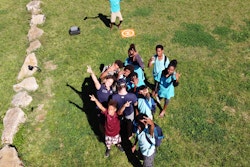Isle of Pines, New Caledonia
The search for sustainable solutions continues on board! Our crew left Grande-Terre to head for the Isle of Pines, a few days away from Noumea.
Coming from: Noumea, New Caledonia
Weather conditions: Sunny
Time of arrival: 1:00 PM

Energy Observer heading to Isle of Pines, New Caledonia
The phenomenon of erosion strongly impacts the Pacific islands, including the Isle of Pines. In New Caledonia, 70% of the coastline is subject to the hazards of erosion, exposing the population to the risks of displacement, land salinization, and land loss.
But according to the IPCC, global warming is not the only cause behind this phenomenon.
How do erosion phenomena work? What role does climate change play in these natural phenomena? Answers with Victorien Erussard and Beatrice Cordiano.
An edible forest
Agroforestry, combining reforestation with agriculture, is a solution tested on the Isle of Pines by Guillaume Vama, president of the association Agir, to develop the island's food autonomy, restore ecosystems and create employment.
If the Isle of Pines is one of the most paradisiacal islands in the world, the issue of energy and food autonomy is instrumental. Therefore, this agroforestry model could thus be further extended and tested on the island of Grande-Terre.
Youth at the core of change
Our crew had the chance to meet students from Saint-Joseph high school to talk to them about Energy Observer and the challenges linked to our Odyssey.
Curiosity, ambition, vision : such was the answer given by the young students, whose questions were multiple. Students who feel more than ever concerned by the stakes of climate change.
Around the world, young people are making their voices heard, at #COP26, but also beyond. Let's keep going!


